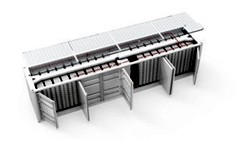The energy landscape is evolving at a rapid pace, and with it, the role of traditional electricity meters is undergoing a significant transformation. Advanced Metering Infrastructure (AMI) is at the forefront of this revolution, offering a new paradigm for energy management. In this article, we will delve into the essential modules that comprise AMI, exploring their functionalities and highlighting the profound impact they have on our ability to monitor and optimize energy consumption. Join us as we uncover the intricate workings of AMI and its potential to reshape the way we interact with energy.
For the energy meter data acquisition and processing you need in any case a few modules.
Head End System (HES)
The Head-End System (HES) plays a crucial role in the Advanced Metering Infrastructure (AMI) by collecting data from smart meters. It serves as the primary interface between the smart meters in the field and the utility's backend systems. The main function of the HES is to read data from the smart meters and provide the results to an interface. While the HES itself does not involve data storage, many vendors have integrated it into their Meter Data Management System (MDMS) for streamlined data management and analysis.
Meter Data Management System (MDMS)
The Meter Data Management System (MDMS) plays a vital role in the Advanced Metering Infrastructure (AMI) by handling the validation and storage of data collected by the Head-End System (HES). Within the MDMS, a Validation-Editing-Estimation (VEE) module is typically employed to validate the incoming data for accuracy and consistency. The validated data is then stored on multiple servers for efficient management.
In addition to data validation and storage, the MDMS performs various other tasks, including:
- Setting tariff structures
The MDMS enables utilities to configure and manage tariff structures for accurate billing and tariff-based calculations. - Read on demand
It facilitates the ability to retrieve meter data on demand, allowing utilities to access real-time information as needed. - Setting load limits
The MDMS allows utilities to set load limits and monitor consumption patterns to manage load demand effectively. - Connect/disconnect customers
It provides the functionality to remotely connect or disconnect customers based on their service requirements. - Managing alarms and events
The MDMS handles the monitoring and management of alarms and events generated by the smart meters, ensuring timely response and resolution. - Managing reports
It generates comprehensive reports and analytics based on the collected meter data, providing valuable insights for decision-making. - Providing APIs
The MDMS offers APIs (Application Programming Interfaces) that enable integration with other applications, allowing seamless data exchange and interoperability.
Customer Information System (CIS)
The Customer Information System (CIS) acts as a vital component in the utility's operations by retrieving necessary data from the Meter Data Management System (MDMS) through an API upon request. The CIS primarily focuses on managing billing processes, customer contracts, customer location information, and other relevant customer data.
One of the key functionalities of the CIS is handling billing operations. It leverages the data obtained from the MDMS to generate accurate and timely bills for customers based on their energy consumption. The CIS ensures that billing information is correctly processed, including the calculation of tariffs, applicable taxes, and any additional charges or discounts as per the customer's contract.
In addition to billing, the CIS also serves as a centralized repository for customer-related information. It manages customer contracts, storing details such as contract start and end dates, service agreements, and associated terms and conditions. The CIS also maintains customer location information, enabling utilities to effectively manage service connections, disconnections, and address changes.
Furthermore, the CIS plays a crucial role in customer relationship management. It provides utilities with a holistic view of customer interactions and histories, allowing them to efficiently address customer inquiries, resolve issues, and provide personalized services. By integrating customer data from multiple sources, the CIS helps utilities gain a comprehensive understanding of their customers, enabling them to deliver superior customer service.
Additional Modules and Supporting Software Tools
- Geographic Information System (GIS)
This module helps utilities visualize and analyse data in a spatial context. It enables the mapping of infrastructure, such as power lines, transformers, and substations, onto geographic maps. With GIS, utilities can make informed decisions about asset placement, network optimization, and maintenance scheduling. - Energy Management System (EMS)
The EMS module focuses on optimizing energy generation, transmission, and distribution. It provides real-time monitoring, control, and optimization of the grid's operational parameters. EMS helps utilities balance supply and demand, manage grid stability, and ensure efficient energy flow. - Supervisory Control and Data Acquisition (SCADA)
SCADA is all about real-time monitoring and control of field devices and equipment. It collects data from sensors, meters, and other devices, enabling utilities to remotely monitor and control their operations. SCADA plays a critical role in grid automation, ensuring reliable and secure operation. - Distribution Management System (DMS)
DMS specifically targets the management of the distribution network. It helps utilities monitor and control the flow of electricity, detect and respond to faults, and optimize distribution system performance. DMS empowers utilities to improve reliability, reduce outage durations, and enhance overall network efficiency. - Asset Management System (AMS)
AMS focuses on managing and maintaining utility assets, such as transformers, switchgear, and cables. It assists in asset lifecycle management, including planning, procurement, maintenance, and retirement. AMS helps utilities optimize asset performance, minimize downtime, and extend asset lifespan. - Outage Management System (OMS)
OMS is essential for timely detection, analysis, and resolution of power outages. It enables utilities to receive and process outage reports, identify affected areas, dispatch field crews, and communicate outage information to customers. OMS aids in reducing outage durations and enhancing customer satisfaction. - Demand Response Management System (DRMS)
DRMS enables utilities to effectively manage and optimize demand response programs. It facilitates the coordination of energy consumption adjustments from participating customers during peak demand periods. DRMS helps utilities balance supply and demand, reduce peak load, and enhance grid reliability. - Mobile Workforce Management System (MWMS)
MWMS supports the efficient coordination and management of field workforce activities. It streamlines tasks such as work order scheduling, dispatching, and tracking. MWMS improves field crew productivity, enhances response times, and enables effective resource allocation. - Distributed Energy Resource Management System (DERMS)
DERMS focuses on the integration and management of distributed energy resources, such as solar panels, wind turbines, and energy storage systems. It optimizes the use of these resources, facilitates grid integration, and enables utilities to actively manage and control distributed generation.
These modules, though diverse in their functionalities, collectively work together to provide utilities with the answers they seek and enable them to take actions based on defined rules. It's like a symphony of interconnected systems, playing in harmony to ensure the smooth operation of the grid.
Embarking on the AMI Journey: Where to Begin?
Implementing an Advanced Metering Infrastructure (AMI) system can be a complex endeavour, but with the right approach, utilities can avoid common pitfalls and set themselves up for success. Let's explore a step-by-step guide to getting started on your AMI journey, ensuring revenue protection and enabling efficient grid control.
- An Up-scalable Head End System
The foundation of a robust AMI system lies in a scalable and reliable Head End System. This central hub acts as the nerve centre, collecting and managing meter data from across the network. By choosing an up-scalable solution, utilities can accommodate future growth and seamlessly handle increasing data volumes. - A Reliable Meter Data Management System
To effectively harness the wealth of meter data, utilities must invest in a reliable Meter Data Management System (MDMS). This system organizes and analyses the data, providing valuable insights and enabling various loss evaluations. With a robust MDMS in place, utilities can efficiently manage events, alarms, and billing processes. - Establishing a Connection to the Customer Management System
Integrating your AMI system with the customer management system is crucial for accurate billing and revenue protection. This connection ensures that the meter data seamlessly flows into the billing processes, enabling accurate consumption calculations and minimizing revenue leakage.
Depending on your specific needs, you may choose to prioritize grid control by incorporating a Supervisory Control and Data Acquisition (SCADA) system as your primary control software. This integration allows for real-time monitoring and control of field devices, enhancing grid stability and performance.
Working with a Trustworthy System Integrator
Tendering an AMI system can be a daunting task, but collaborating with a reliable and experienced system integrator is key to success. Engage in a dialogue with different vendors, discussing your unique ideas, needs, and visions. By leveraging their expertise, you can shape a tailored solution that meets your requirements and ensures a smooth implementation.
Final Thoughts
The success of your AMI system relies on careful planning, collaboration, and selecting the right partners. Take the time to align your objectives, engage in meaningful discussions, and build a solution that sets your utility on the path to operational excellence.
If you have any inquiries or need further information about starting your AMI journey, please do not hesitate to reach out to us. We are here to assist you and welcome your valuable thoughts and comments.
Editor's note: This article was originally published in July 2020 and has been updated for comprehensiveness.





Thank you for answering my question and thank you for all the articles on your blog. It is appreciated!
Thank you for the kind reply and your interest in our articles about metering. It's always rewarding to hear that people are finding them useful.
Please can you tell me the difference between an event and an alarm? Can you give me a real example of each that a CLOU meter will produce?
Thank you for your question. I suggest you read the article about event logs. In general, an alarm can be triggered from each event, but not each event is worth to trigger an alarm. The individual configuration is always done with the utility to meet their specific needs.
My concern is the mode of data acquisition from the meter to the HES bearing in mind the cost.
Which communication method would you recommend and why?
When we consider the annual operational costs, the power line communication (PLC) is still the most cost-effective way to connect domestic energy meters with the head end system. With all other methods you are in the hand of telecommunication companies for each single node. Some IoT solutions are coming up, but I haven't seen dedicated carrier costs so far. Maybe you take a look at the article "Smart Meters and the Internet of Things".
Please I'm Paul from Benin republic Cotonou precisely someone tampered with my meter so it's not connecting again please how can fix it back
You need to inform your local power supply company. They can give you a clear tamper token.
I like watch TV.
Thanks for your comment, Jennifer. I also like.